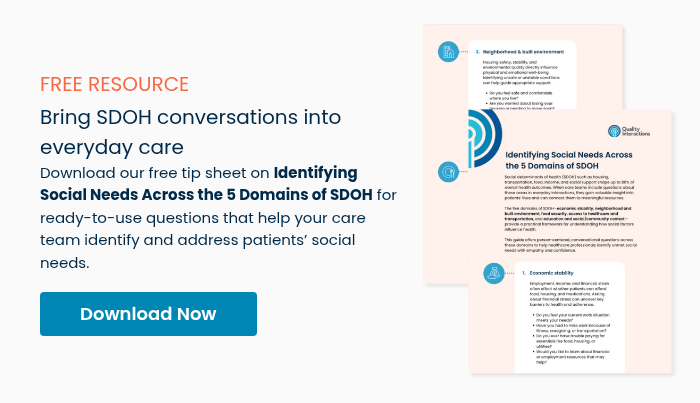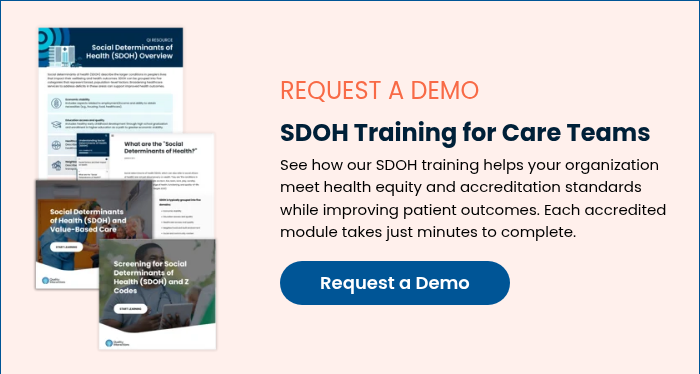
Across healthcare settings, providers see the ways social and economic conditions shape patient outcomes. A person who struggles to afford healthy food, misses appointments because of unreliable transportation, or feels unsafe at home, is facing barriers that medical care alone can't solve.
Social determinants of health (SDOH) influence up to 80 percent of overall health outcomes. When care teams include conversations about SDOH in routine practice, they uncover the root causes behind many health challenges, strengthen communication, and connect patients with meaningful support.
How to overcome barriers to SDOH conversations
Even when clinicians understand the importance of social determinants of health, many hesitate to begin the conversation. Limited time, discomfort with sensitive topics, or uncertainty about follow-up can make SDOH screening feel daunting. Patients may also be reluctant to share personal details.
The key is transparency and empathy. Explain the purpose of these questions so patients feel comfortable and understood:
“We ask everyone these questions because things like housing, transportation, and food can affect health.”
When patients recognize that SDOH discussions are a standard part of care, not an evaluation of personal choices, they are more likely to engage openly.
Practical steps to integrate SDOH screening into everyday workflows
Normalize the process. Include SDOH screening in intake forms, EHR templates, and routine assessments so every patient receives the same level of attention.
Start small. Focus first on one domain, such as food security or transportation, then expand to cover all five domains of social determinants of health.
Use person-centered phrasing. Replace yes-or-no questions with open-ended prompts like “Do you feel safe where you live?” or “Is transportation ever a challenge for you?”
Empower the full care team. SDOH conversations should involve everyone, including nurses, social workers, care coordinators, and administrative staff. Each person plays a role in identifying barriers and facilitating connections to resources.
Follow through. Document needs accurately, make timely referrals, and follow up. Even small actions, such as sharing a local resource list, build trust and improve adherence.
Understanding the five domains of social determinants of health
Organizing screening questions around the five domains of SDOH provides structure and consistency for care teams.
Organizing screening questions around the five domains of SDOH provides structure and consistency for care teams. These domains, defined by Healthy People 2030, are:
-
Economic stability: Employment, income, and financial security influence access to basic needs such as food, housing, and medications.
-
Education access and quality: Education and health literacy affect a person’s ability to find, understand, and use health information to make informed decisions.
-
Health care access and quality: Timely, affordable, and culturally responsive care is essential for prevention, early intervention, and ongoing management of conditions.
-
Neighborhood and built environment: Safe housing, clean air and water, and access to transportation and healthy foods all contribute to overall health.
-
Social and community context: Relationships, social support, and experiences of inclusion or discrimination influence both emotional and physical well-being.
Using these domains helps care teams identify unmet needs, strengthen relationships, and connect patients to the right resources.
Turning SDOH insights into action
Identifying a social need is just the beginning. The real impact comes
Identifying a social need is just the beginning. The real impact comes when care teams act on what they learn. Healthcare organizations that establish clear referral pathways and maintain up-to-date resource lists ensure that SDOH conversations lead to measurable results.
Even small interventions, such as connecting a patient with transportation assistance or a local food program, can improve adherence, reduce readmissions, and increase satisfaction. When every team member views social determinants of health as essential to quality care, patients experience healthcare that is more responsive, equitable, and effective.
Putting SDOH into practice for better outcomes
Integrating social determinants of health into daily workflows does not require more time, only a shift in approach. Start with brief, person-centered questions and maintain consistency across your team. Over time, these conversations become routine, reveal valuable insights, and support better outcomes for every patient.
Download the free tip sheet
Download our free tip sheet, Identifying Social Needs Across the 5 Domains of SDOH, for ready-to-use questions your care team can integrate into patient interactions today.
You may also like:
- Training Care Teams to Address Social Determinants of Health
- Understanding Social Determinants of Health: Five Key Areas for Providers
- Avoiding Assumptions: Person-Centered Care for Improved Outcomes
- Using the Teach-Back Method to Improve Health Literacy [Tip Sheet]


